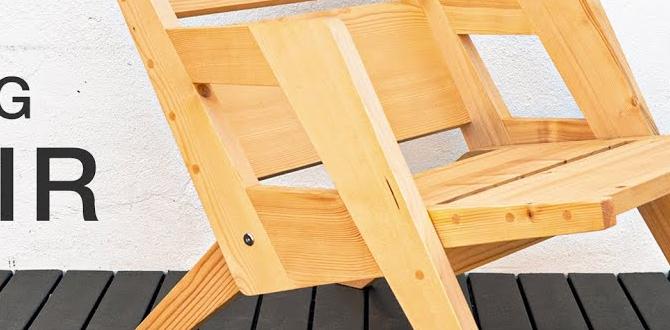Nail gun jams happen, but you can fix them! This guide provides a simple, step-by-step process to safely remove jammed nails from your nail gun, getting you back to your project quickly and confidently.
Hey there, fellow DIYer! Jack Shaffer here from Nailerguy. We’ve all been there: you’re in the middle of a project, feeling that awesome DIY groove, and BAM! Your nail gun jams. It’s frustrating, right? You might be tempted to pull and tug, maybe even whack it, but hold on! Most nail gun jams are surprisingly easy to fix if you know the right method. This guide is here to walk you through it, step-by-step, so you can clear that jam safely and get back to building with confidence. We’ll cover the why and how, making sure you’re prepared for any sticky situation.
Table of Contents
Why Do Nail Guns Jam and How to Prevent Them
Understanding why jams happen is the first step to avoiding them. It’s usually a simple mechanical issue, often caused by a few common culprits. Knowing these will save you a lot of headaches down the road!
Common Causes of Nail Gun Jams
- Incorrect Nail Size: Using nails that are too long, too short, or the wrong gauge for your specific nail gun is a major cause. Always check your tool’s manual for recommended nail specifications.
- Low Air Pressure (for pneumatic nailers): If the air compressor isn’t providing enough pressure, the nail might not be driven all the way, leading to a jam. Ensure your regulator is set to the manufacturer’s recommended PSI.
- Dust and Debris: Over time, dust, wood shavings, and old lubricant can build up inside the magazine and firing mechanism, obstructing the nail path.
- Damaged Nose or Magazine: A bent tip on the nail gun’s nose or a damaged magazine can prevent nails from feeding correctly.
- Faulty O-rings or Seals: Worn-out internal parts can lead to air leaks or improper firing, contributing to jams.
- Accidental Dry Firing: Repeatedly firing the nail gun without a surface to drive a nail into can sometimes cause internal misalignment and jams.
- Improper Loading: Not seating the nail strip properly, or trying to load bent nails, can easily lead to a jam.
Preventative Maintenance Tips
Prevention is always better than a cure. A little regular care goes a long way in keeping your nail gun running smoothly.
- Use the Right Nails: This is crucial. Always refer to your nail gun’s manual for compatible nail sizes and types.
- Keep it Clean: Regularly clean the exterior of your nail gun, especially the magazine and nose. A quick wipe-down after each use is ideal.
- Lubricate (if required): Some pneumatic nailers require a few drops of special oil daily. Refer to your manual; over-oiling can attract dirt.
- Check Air Pressure: For pneumatic models, ensure your air compressor is set to the correct PSI range specified by the nail gun manufacturer.
- Inspect Regularly: Before each use, quickly check the nose and magazine for any visible damage.
- Proper Storage: Store your nail gun in a clean, dry place.
For more in-depth maintenance advice, consult the Occupational Safety and Health Administration (OSHA) guidelines on power-activated tool safety, which often include maintenance recommendations.
The Essential Nail Gun Jam Removal Guide: Step-by-Step
Okay, it happened. Don’t panic! Follow these steps carefully. Safety is the absolute priority here, so always take your time and be methodical.
Step 1: Safety First – Power Down!
This is non-negotiable. Before you even think about touching the nail gun, you MUST disconnect the power source. This means:
- For Pneumatic Nailers: Disconnect the air hose from the nail gun.
- For Electric/Cordless Nailers: Remove the battery pack or unplug the power cord.
This simple step prevents accidental firing while you’re working on the jam, which could cause serious injury. Never skip this!
Step 2: Identify the Jammed Nail
Look closely at the nose of your nail gun. Can you see a nail sticking out, bent, or lodged in the mechanism? Sometimes, the jam is visible from the outside. Other times, you might need to open up the magazine or casing a bit (refer to your tool’s manual for specifics on how to access the firing chamber if necessary). Gently try to see where the nail is stuck.
Step 3: Attempt to Extract Visible Nails
If a nail is sticking out of the nose, try to grasp it firmly with a pair of pliers or vise-grips. Gently wiggle the nail back and forth while pulling smoothly. Avoid yanking, as this can break the nail and make removal harder.
What if the nail won’t budge? Don’t force it too hard! Excessive force could damage the nail gun. If it’s stuck tight, proceed to the next steps.
Step 4: Open the Magazine/Nose Assembly
Most nail guns have a mechanism to open the nose or magazine for clearing jams. This often involves sliding a latch, flipping a lever, or removing a small screw. Again, consult your nail gun’s manual if you’re unsure how this works for your specific model.
Opening this section usually exposes the firing chamber and the path where the nails are fed. This gives you better access to the jammed nail.
Step 5: Carefully Remove the Obstruction
Once the area is accessible:
- With Pliers: Carefully try to grip the jammed nail with your pliers and gently pull it straight out. If the nail is broken, try to grab any protruding pieces.
- Use a Flathead Screwdriver (with caution): In some cases, a small flathead screwdriver can be used to gently pry a stuck nail loose. Be very careful not to scratch or damage the delicate internal components of the nail gun.
- Tap Gently: Sometimes, a very light tap on the side of the jammed nail with the handle of your pliers or a small wooden dowel can help dislodge it.
Important: Never insert your fingers into the nose of the nail gun, even when it’s disconnected from power. Always use tools.
Step 6: Clear Any Debris
While you have the assembly open, take a moment to clear out any dust, wood shavings, or broken nail fragments. A small brush or compressed air (used carefully and at low pressure) can be helpful here. A clean mechanism is less likely to jam again soon.
Step 7: Reload and Test
Once the jam is cleared and the area is clean, carefully close the magazine or nose assembly. Ensure it latches securely.
Now, reconnect the power source (air hose or battery/cord).
Test Fire: Before going back to your project, point the nail gun at a scrap piece of wood and fire it once. This confirms that the mechanism is working correctly and no nails are jamming.
Troubleshooting Common Jam Scenarios
Not all jams are created equal. Here are a few specific sticky situations and how to tackle them.
Scenario 1: A Nail is Bent and Stuck Deep
If you can see a bent nail lodged inside the firing chamber and pliers can’t get a good grip:
- Try to use the tip of a small flathead screwdriver or an awl to gently push or lever the bent section of the nail so you can get a better grip with your pliers.
- If the nail has broken off, you may need to look for specialized tools like a needle-nose pliers with a good gripping surface or even a small probe to carefully back the nail fragment out.
- In some severe cases, you may need to consult your tool’s manual for more advanced disassembly procedures. However, for beginners, it’s often best to try these basic methods first.
Scenario 2: The Nail Just Won’t Feed into the Chamber
This often means there’s a blockage further back in the magazine or the feeding mechanism itself is misaligned. After disconnecting power:
- Empty the magazine completely.
- Inspect the magazine track for any bent nails or foreign objects.
- Check the spring-loaded pusher – sometimes this can get stuck or jammed. Gently try to move it back and forth.
- If you have a secondary access point to the feed mechanism (check manual), open it and try to clear any obstructions.
Scenario 3: “Riding Nail” – A Nail is Partially Fired but Stuck
This is when a nail has been partially driven but didn’t fully exit. It might be sticking out of the nose or lodged just inside.
- Disconnect power immediately.
- Often, a direct, firm pull with pliers on the exposed portion of the nail is enough.
- Sometimes, the nail might be buckled against the staple guides in the nose. You might need to gently tap the nail head forward (towards the material) to straighten it slightly before pulling it back out.
Choosing the Right Nailer for Your Project
Preventing jams also starts with using the right tool for the job. Different nail guns are designed for different tasks and materials. Choosing wisely reduces stress on the tool and yourself.
Types of Nail Guns
Here’s a quick rundown of common nailer types:
| Nail Gun Type | Common Uses | Pros | Cons |
|---|---|---|---|
| Framing Nailer | House framing, deck building, subflooring | Drives large nails quickly, powerful | Heavy, requires high air volume if pneumatic |
| Finish Nailer | Trim work, molding, baseboards, chair rails | Drives smaller nails with less impact, precise | Not for structural work |
| Brad Nailer | Light trim, decorative molding, small crafts | Very fine nails, minimal damage to wood | Extremely limited in strength; only for very light applications |
| Pin Nailer | Attaching delicate trim, holding small pieces while glue dries | Almost invisible nail holes, no pre-drilling needed | No holding power on its own; strictly for tacking |
| Roofing Nailer | Attaching shingles and felt paper | Large magazine capacity, fast | Specialized; only for roofing |
| Siding Nailer | Installing vinyl or wood siding | Special nose for siding, consistent depth | Specific to siding installation |
Power Source Considerations
Nail guns are powered in a few ways:
- Pneumatic (Air-Powered): Most popular for professional use. Requires an air compressor. Offers consistent power but requires an air hose.
- Electric (Corded): Plugs into a standard outlet. Convenient for indoor work where an outlet is nearby. Limited by cord length.
- Cordless (Battery-Powered): Offer maximum portability. Battery technology has improved significantly, offering good power and runtime. Can be more expensive initially.
- Gas Cartridge (Fuel Cell): Common in cordless framing and finishing nailers. A fuel cell releases gas that ignites to drive the nail. Offers high portability but requires ongoing fuel cell purchases.
Choosing a nailer that matches your project’s scale, your budget, and your comfort level with different power sources will naturally lead to fewer problems, including jams.
When to Seek Professional Help
While most jams are DIY-fixable, there are times when it’s best to step back and call in an expert. If:
- You’ve tried the steps above and the jam persists.
- You hear a strange clicking or grinding noise that wasn’t there before.
- You’ve had to disassemble parts of the nailer beyond what your manual shows and aren’t comfortable reassembling it.
- You suspect a major internal component has failed (e.g., a cracked piston, a broken spring).
- You’ve damaged the nail gun during an attempt to clear a jam.
In these situations, it’s better to take your nail gun to an authorized service center or a tool repair shop than to risk further damage or personal injury. A qualified technician can diagnose and fix issues that are beyond basic troubleshooting.
Frequently Asked Questions (FAQ)
Q1: How do I know if my nail gun is disconnected from power?
For pneumatic nailers, the air hose will be disconnected. For electric or cordless models, the battery will be removed, or the power cord will be unplugged. Visually confirm this before touching any part of the nailer’s mechanism.
Q2: Can I use pliers to remove a jammed nail?
Yes, pliers are often the best tool for gripping and pulling a jammed nail. Needle-nose pliers offer more precision if the nail is in a tight spot.
Q3: What is the most common reason for a nail gun jam?
The most common reasons are using the wrong size or type of nails for the tool and insufficient air pressure (for pneumatic nailers).
Q4: Should I force a jammed nail out?
No, never force a jammed nail. Excessive force can bend or break the nail further, damage the nail gun’s internal components, or even cause injury. Gentle, steady pulling is key.
Q5: How often should I clean my nail gun?
It’s good practice to wipe down your nail gun, especially the magazine and nose, after each use. A more thorough cleaning of the internal feeding parts can be done every few months or as needed, depending on how frequently you use the tool and the environment you work in.
Q6: My nail gun is still jamming after I cleared a nail. What else could be wrong?
If jams keep happening, check your nail supply for bent nails, ensure your air pressure is set correctly (if pneumatic), and consider if the tool needs a more thorough cleaning or minor internal maintenance. Worn O-rings or seals can also cause recurring issues. Refer to your manual or a service professional.
Q7: Can I use WD-40 to clean my nail gun?
WD-40 is a water dispersant and light lubricant, but it’s generally not recommended as the primary lubricant for nail guns. It can attract dust and gunk over time. Most pneumatic nailers require specialized air tool oil. Always use products recommended by your nail gun’s manufacturer.
Conclusion
Dealing with a jammed nail gun can feel like a roadblock, but as you’ve seen, it’s usually a solvable problem. By prioritizing safety, following a methodical step-by-step process, and performing regular maintenance, you can keep your tools running smoothly and your projects on track. Remember to always disconnect the power source first, patiently remove obstructions, and then test your nailer before diving back into your work. Mastering these simple jam removal techniques will save you time, frustration, and potentially money on repairs. Happy building, and may your nail gun always be ready!



